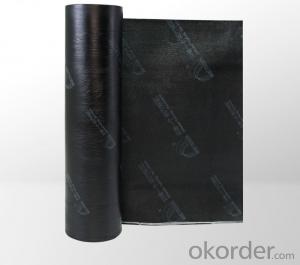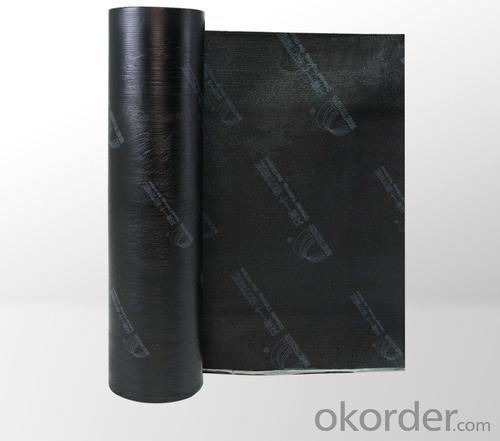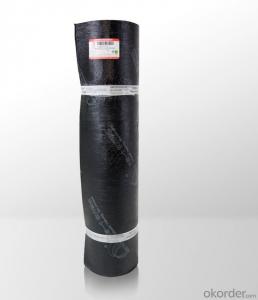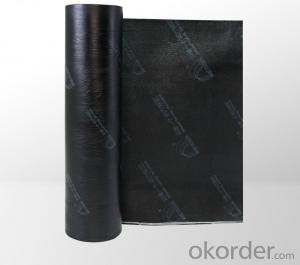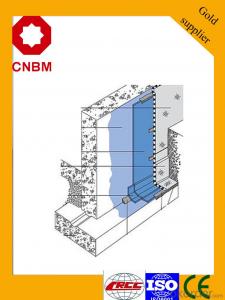PMB-751 Plastomer (APP) Modified Bituminous Water Proof Sheet Material
- Loading Port:
- China main port
- Payment Terms:
- TT OR LC
- Min Order Qty:
- 1000 m²
- Supply Capability:
- 500000 m²/month
OKorder Service Pledge
OKorder Financial Service
You Might Also Like
Plastomer (APP) modified Bitumious Water Proof Sheet Material is a modified bituminous dipping
and coatingmaterial made out of atactic polypropylene (APP) and polyolefins(APAO,APO) it is a kind of rollable sheet water proof materials with the upper surface cover of the isolating materials like polyethylene film, fine sand or mineral slice (or particle) etc.
Type and Specification
·The physical and mechanical properties were divided in
Type Ⅰ and Type Ⅱ .
·Classified by filler base: Polyester filler(PY), glass fiber
filler(G) and glass fiber reinforced polyester filler felt(PYG).
·Classified by upper surface isolating material: Polyethylene
film (PE), fine sand (S) and mineral particle (M).
·Classified by lower surface isolating material: Fine sand (S) (
note: the mineral particle with the fine sand diameter not more
than 0.6mm) and polyethylene film (PE).
Advantages
—Filament polyester filler base sheet material:
·Combination of high performance filament polyester filler and
APP modified bitumen , forming an exellent performance .
·Form high strength water proof layer, to have strong water
resistance capability.
·It is of high tensile strength, high elongation, and adaptive to
shrinkage, deformation and fracture of base.
·Good performance of low temperature resistance, corrosion
resistance, mould resistance and weather resistance.
·Large thickness of the high strength polyester filler, resistance of
puncture, breaking, tearing and fatigue.
·Good workability, we may construct by hot melt method during
the four seasons in the whole year, hot-joint is reliable and durable.
—Alkali free glass fiber filler sheet material:
·Combination of economical filler base and high performance APP
modified bitumen; to from a high tensile strength,large thickness,
strong resistance of wearing and good dimensional stability.
·Excellentl high temperature resistance, corrosion resistance,
mould resistance and weather resistance.
·Good workability, we may construct by hot melt method during
the four seasons in the whole year, hot-joint is reliable and durable.
—Glass fiber reinforced polyester sheet material:
·We adopt mechanical mounting construction method, safe and
environmentally friendly, and the product has better dimensional
stability and fire-resistance performance.
Application Range
Used in different water proof engineering of all industrial
and civil sections, be mostly appropriate to the following
engineerings:
·Water proof for roof engineering of industrial and civil
construction, including normal and special roof like non-human
walking roof, human walking roof, thermal insulation roof, non-thermal-insulation roof, planted roof, roof parking lot, upside-down
roof etc.
·Underground water proof and damp proof for industrial and civil
construction, indoor swimming pool and fire pool water proof etc.
·Municipal construction waterproofing like subway, tunnel,
concrete road surface and bridge surface, sewage works and
refuse landfill etc.
·Water conservancy facilities waterproofing engineering for canal
and water pool etc.
Application range for different filler base and surface
sheet material:
·Glass fiber filler base sheet material: Appropriate to normal roof
of structurally stable building and to underground engineering.
·Filament polyester filler sheet material: Appropriate to Grade Ⅰ
and Grade Ⅱ roofing project water proof and underground project.
- Q: Can waterproofing membranes be used on concrete stairs?
- Yes, waterproofing membranes can be used on concrete stairs. These membranes are designed to create a protective barrier against water penetration, which is particularly important for areas exposed to moisture such as outdoor or basement stairs. Applying a waterproofing membrane on concrete stairs can help prevent water damage, increase their durability, and extend their lifespan.
- Q: Floor tiles on the terrace leak, can be directly on the brick shop SBS coil and then cast the cement?
- 5, the new waterproof material "water does not leak", "water does not leak" appearance, material, the use of similar materials and cement, not easily cracked, very strong adhesion, suitable for small-scale use, when other waterproofing process is not Suitable, such as small space, other processes can not start, with "water does not leak" more appropriate. Usually mixed with cement and sand.
- Q: Can a waterproofing membrane be installed by a DIYer?
- Installing a waterproofing membrane can be done by someone who wants to do it themselves. However, it is important to keep in mind that the installation process can be complicated and requires careful attention to detail. It is crucial to thoroughly understand the instructions and guidelines provided by the manufacturer before attempting the installation. In addition, it is essential to properly prepare the surface in order to have a successful installation. This may involve cleaning, leveling, and priming the surface to ensure that the membrane adheres correctly. It is also important to choose the appropriate type and thickness of membrane for the specific application. Moreover, DIYers should have the necessary tools and equipment, like a trowel or roller, to apply the membrane accurately. Depending on the specific membrane and installation method, specialized tools may also be required in some cases. Considering safety measures is also important. It is recommended to wear protective gear and work in a well-ventilated area. Some waterproofing membranes may involve the use of hazardous chemicals, so it is crucial to follow all safety instructions provided by the manufacturer. If you are uncertain about your ability to properly install a waterproofing membrane, it is advisable to seek advice from a professional contractor who specializes in waterproofing. They have the knowledge and expertise to ensure a correct installation that will effectively protect your property from water damage.
- Q: Does a waterproofing membrane have any impact on the thermal performance of a structure?
- Yes, a waterproofing membrane can have an impact on the thermal performance of a structure. A waterproofing membrane is typically used in buildings to prevent water infiltration, which can cause damage to the structure over time. By creating a barrier against moisture, the membrane helps to maintain the integrity of the building envelope and protect against potential leaks or water damage. In terms of thermal performance, a waterproofing membrane can help to improve insulation by reducing the amount of heat transfer through the building envelope. By preventing moisture from entering the structure, the membrane also helps to prevent the formation of condensation, which can lead to mold growth and further damage to the building materials. Furthermore, some waterproofing membranes are designed with additional insulation properties, such as foam or reflective coatings, which can further enhance the thermal performance of a structure. These membranes help to reduce thermal bridging and improve energy efficiency by minimizing heat loss or gain through the building envelope. It is important to note that the impact of a waterproofing membrane on the thermal performance of a structure can vary depending on the specific type of membrane, its installation, and the overall design of the building. It is advisable to consult with a professional architect or engineer to determine the most suitable waterproofing solution that meets both the water resistance and thermal performance requirements for a particular structure.
- Q: Are waterproofing membranes resistant to battery acid?
- Waterproofing membranes are typically not specifically designed to be resistant to battery acid. The purpose of waterproofing membranes is to provide a barrier against water and moisture, and they are typically made of materials such as bitumen, rubber, or modified asphalt. While these materials may have some level of resistance to certain acids, they are not typically designed to withstand the corrosive properties of battery acid. Battery acid, which is typically sulfuric acid, can cause significant damage to many materials, including waterproofing membranes. If you are working with battery acid or have a situation where exposure to battery acid is a concern, it is recommended to use materials specifically designed to resist the corrosive effects of battery acid or consult with a professional for appropriate solutions.
- Q: Is a waterproofing membrane resistant to punctures?
- Yes, a waterproofing membrane is typically designed to be resistant to punctures. Waterproofing membranes are made of flexible materials such as rubber, PVC, or bitumen that are specifically engineered to be durable and resistant to damage. They are often reinforced with additional layers or coatings to provide extra strength and puncture resistance. However, it is important to note that the level of puncture resistance can vary depending on the specific type and quality of the waterproofing membrane. Therefore, it is crucial to choose a high-quality membrane and ensure proper installation to maximize its resistance to punctures and ensure long-term waterproofing protection.
- Q: Can a waterproofing membrane be used for a retaining wall drainage?
- Yes, a waterproofing membrane can be used for retaining wall drainage. The membrane helps to prevent water from seeping into the retaining wall and causing damage. Additionally, it can also help to channel water away from the wall, promoting proper drainage.
- Q: Can a waterproofing membrane be used in conjunction with green building practices?
- Yes, a waterproofing membrane can definitely be used in conjunction with green building practices. In fact, incorporating a waterproofing membrane into the construction of a green building can help enhance its overall sustainability and efficiency. One of the key principles of green building practices is to maximize energy efficiency and reduce the environmental impact of a building. By installing a waterproofing membrane, the building's envelope can be protected from moisture intrusion, preventing water damage and potential mold growth. This, in turn, helps maintain the structural integrity of the building, reducing the need for repairs and replacements, which can be resource-intensive and generate waste. Additionally, a waterproofing membrane can contribute to better indoor air quality. By preventing water infiltration, it helps create a dry and healthy living or working environment, minimizing the risk of respiratory issues and other health problems associated with dampness. Furthermore, a waterproofing membrane can improve the energy efficiency of a building. By preventing water from seeping into the walls or foundation, it reduces the potential for heat loss through moisture evaporation, thus reducing the energy needed for heating and cooling. This can lead to reduced energy consumption and lower carbon emissions, aligning with the goals of green building practices. It is important, however, to choose a waterproofing membrane that is environmentally friendly and meets green building standards. Look for membranes that are made from recycled or sustainable materials and have low VOC (volatile organic compound) content. Additionally, consider selecting a membrane that is designed for durability and longevity, as this can further reduce the environmental impact by minimizing the need for replacement over time. In conclusion, a waterproofing membrane can be a valuable addition to any green building project. It helps protect the building envelope, improves indoor air quality, and enhances energy efficiency. By selecting an environmentally friendly membrane, the overall sustainability of the building can be further improved.
- Q: How does a waterproofing membrane handle settlement cracks?
- Waterproofing membranes are specifically designed to address settlement cracks by offering a continuous and flexible barrier that effectively blocks water infiltration. Settlement cracks arise when the ground beneath a structure shifts or settles, resulting in foundation cracks. These cracks can allow water to seep into the building, causing moisture damage and potential structural problems. In the event of a settlement crack, applying a waterproofing membrane to the affected area creates a seamless and watertight seal. This membrane acts as a protective layer that prevents water from entering through the crack and penetrating the building. Furthermore, it plays a vital role in maintaining the foundation's structural integrity by reducing the likelihood of additional cracking and deterioration. The flexibility of the waterproofing membrane is essential in handling settlement cracks. It can accommodate the movements of the underlying structure without compromising its performance. As the ground settles or shifts, the membrane stretches and contracts, ensuring that the crack remains sealed and the waterproofing system remains intact. Moreover, certain waterproofing membranes possess self-healing properties. This means that if a settlement crack does occur, the membrane has the ability to reseal itself, preserving its watertight integrity. This self-healing capability minimizes the need for frequent repairs and maintenance, leading to time and cost savings for property owners. In conclusion, a waterproofing membrane is a highly effective solution for addressing settlement cracks. It provides a durable and flexible barrier that prevents water infiltration, guards against further damage, and contributes to the longevity of the structure.
- Q: Can waterproofing membranes be used on concrete block walls?
- Yes, waterproofing membranes can be used on concrete block walls. These membranes are specifically designed to prevent water penetration and can effectively protect concrete block walls from moisture damage.
Send your message to us
PMB-751 Plastomer (APP) Modified Bituminous Water Proof Sheet Material
- Loading Port:
- China main port
- Payment Terms:
- TT OR LC
- Min Order Qty:
- 1000 m²
- Supply Capability:
- 500000 m²/month
OKorder Service Pledge
OKorder Financial Service
Similar products
Hot products
Hot Searches
Related keywords
